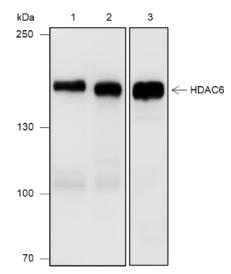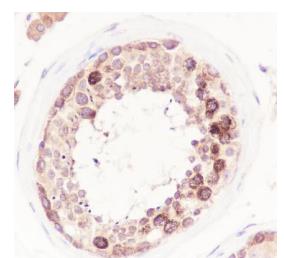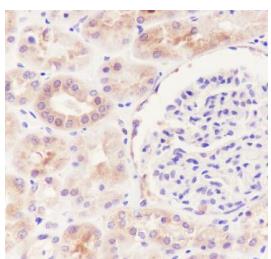
Rabbit Anti-HDAC6 antibody
HD 6; HD6; HDAC 6; Histone deacetylase 6; HD6; Histone deacetylase 6; JM 21; JM21; KIAA0901; FLJ16239; HDAC6_HUMAN.
View History [Clear]
Details
Product Name HDAC6 Chinese Name 组蛋白去乙酰化酶6Recombinant rabbit monoclonal anti Alias HD 6; HD6; HDAC 6; Histone deacetylase 6; HD6; Histone deacetylase 6; JM 21; JM21; KIAA0901; FLJ16239; HDAC6_HUMAN. Research Area Tumour Developmental biology Signal transduction Apoptosis transcriptional regulatory factor Epigenetics Immunogen Species Rabbit Clonality Monoclonal Clone NO. 6B4 React Species Human, Applications WB=1:1000-2000 ELISA=1:5000-10000 IHC-P=1:100-500 IHC-F=1:50-200 ICC=1:50-200 IF=1:50-200 (Paraffin sections need antigen repair)
not yet tested in other applications.
optimal dilutions/concentrations should be determined by the end user.Theoretical molecular weight 134kDa Cellular localization The nucleus cytoplasmic Form Liquid Concentration 1mg/ml immunogen Recombinant human HDAC6 protein, around C-terminal 150aa Lsotype IgG Purification affinity purified by Protein A Buffer Solution 0.01M TBS(pH7.4) with 1% BSA, 0.03% Proclin300 and 50% Glycerol. Storage Shipped at 4℃. Store at -20 °C for one year. Avoid repeated freeze/thaw cycles. Attention This product as supplied is intended for research use only, not for use in human, therapeutic or diagnostic applications. PubMed PubMed Product Detail Histones play a critical role in transcriptional regulation, cell cycle progression, and developmental events. Histone acetylation/deacetylation alters chromosome structure and affects transcription factor access to DNA. The protein encoded by this gene belongs to class II of the histone deacetylase/acuc/apha family. It contains an internal duplication of two catalytic domains which appear to function independently of each other. This protein possesses histone deacetylase activity and represses transcription. [provided by RefSeq, Jul 2008].
Function:
Responsible for the deacetylation of lysine residues on the N-terminal part of the core histones (H2A, H2B, H3 and H4). Histone deacetylation gives a tag for epigenetic repression and plays an important role in transcriptional regulation, cell cycle progression and developmental events. Histone deacetylases act via the formation of large multiprotein complexes. Plays a central role in microtubule-dependent cell motility via deacetylation of tubulin.
In addition to its protein deacetylase activity, plays a key role in the degradation of misfolded proteins: when misfolded proteins are too abundant to be degraded by the chaperone refolding system and the ubiquitin-proteasome, mediates the transport of misfolded proteins to a cytoplasmic juxtanuclear structure called aggresome. Probably acts as an adapter that recognizes polyubiquitinated misfolded proteins and target them to the aggresome, facilitating their clearance by autophagy.
Subunit:
Interacts with CBFA2T3, HDAC11 and SIRT2. Interacts with F-actin. Interacts with BBIP10. Under proteasome impairment conditions, interacts with UBD via its histone deacetylase 1 and UBP-type zinc-finger regions. Interacts with CYLD. Interacts with ZMYND15 (By similarity). Interacts with DDIT3/CHOP.
Subcellular Location:
Nucleus. Cytoplasm. Note=It is mainly cytoplasmic, where it is associated with microtubules.
Post-translational modifications:
Phosphorylated by AURKA.
Ubiquitinated. Its polyubiquitination however does not lead to its degradation.
Sumoylated in vitro.
Similarity:
Belongs to the histone deacetylase family. HD type 2 subfamily.
Contains 1 UBP-type zinc finger.
SWISS:
Q9UBN7
Gene ID:
10013
Database links:Entrez Gene: 10013 Human
Entrez Gene: 15185 Mouse
Omim: 300272 Human
SwissProt: Q9UBN7 Human
SwissProt: Q9Z2V5 Mouse
Unigene: 6764 Human
Unigene: 29854 Mouse
Unigene: 13453 Rat
Product Picture
Primary Ab dilution: 1:1000
Primary Ab incubation condition: 2 hours at
room temperature
Secondary Ab: Goat Anti-Rabbit IgG H&L
(HRP)
Lysate: 1: HeLa, 2: COS-7, 3: K562
Protein loading quantity: 20 μg
Exposure time: 60 s
Predicted MW: 131 kDa
Observed MW: 160 kDa
Tissue: Human testis
Section type: Formalin-fixed & Paraffin
-embedded section
Retrieval method: High temperature and high
pressure
Retrieval buffer: Tris/EDTA buffer, pH 9.0
Primary Ab dilution: 1:50
Primary Ab incubation condition: 1 hour at
room temperature
Secondary Ab: Anti-Rabbit and Mouse
Polymer HRP (Ready to use)
Counter stain: Hematoxylin (Blue)
Comment: Color brown is the positive signal for
SLM-52086RTissue: Human kidney
Section type: Formalin-fixed & Paraffin
-embedded section
Retrieval method: High temperature and high
pressure
Retrieval buffer: Tris/EDTA buffer, pH 9.0
Primary Ab dilution: 1:50
Primary Ab incubation condition: 1 hour at
room temperature
Secondary Ab: Anti-Rabbit and Mouse
Polymer HRP (Ready to use)
Counter stain: Hematoxylin (Blue)
Comment: Color brown is the positive signal for
SLM-52086R
References (0)
No References
Bought notes(bought amounts latest0)
No one bought this product
User Comment(Total0User Comment Num)
- No comment





 +86 571 56623320
+86 571 56623320
 +86 18668110335
+86 18668110335

